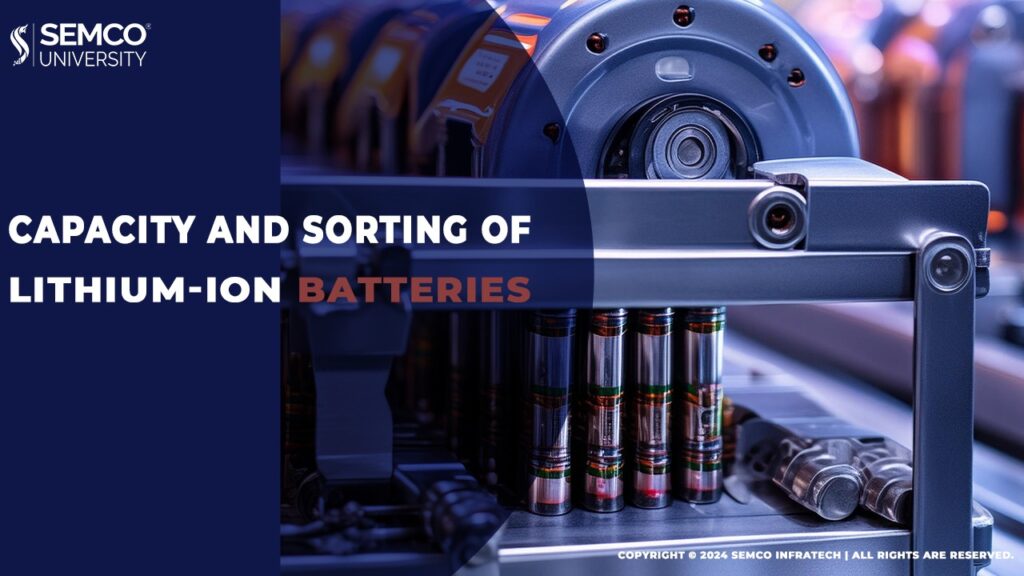In lithium-ion battery production, even slight variations can significantly impact performance. Capacity and sorting are crucial steps that guarantee consistent battery quality, leading to reliable and dependable battery packs.
The Need for Sorting
During manufacturing, subtle differences in the environment or process conditions can lead to variations in performance, even for batteries of the same model and batch. Capacity classification identifies these differences by testing each battery’s capacity through charging and discharging cycles. Sorting then segregates batteries based on various performance indicators and product grade standards. Qualified batteries are shipped to customers, while those failing to meet standards are either recycled, discounted, or discarded.
Sorting Criteria
Sorting parameters are divided into two categories: full inspection and random inspection. Full inspection involves testing every battery for factors like open-circuit voltage, self-discharge, internal resistance, and dimensions. Random inspection, using sampling methods, focuses on electrical and safety performance, including cycle life, high/low-temperature behavior, and resistance to short circuits, overcharge, and physical impact.
For instance, aluminum shell batteries undergo an initial voltage test after aging to assess self-discharge. Batteries failing this test require a second voltage test and potential recharge. Those still failing are deemed unusable. Qualified batteries proceed to receive an insulating film for electrode protection and then undergo capacity sorting. Following this, internal resistance is measured, and lastly, thickness is checked. Unqualified batteries based on thickness are flattened and re-measured to be categorized for different product grades.
The stringency of full inspection parameters directly impacts the qualified rate. Stricter control leads to a lower qualified rate and increased manufacturing costs. Capacity sorting parameters are typically negotiated between the manufacturer and the customer based on the manufacturer’s capabilities and the customer’s specific requirements.

Factors Affecting Battery Performance
Several factors influence various battery performance indicators:
- Self-discharge: This is primarily caused by internal negative reactions and micro-short circuits. Impurities on electrode surfaces or metal burrs can contribute to these short circuits. Higher formation voltage and aging temperature can help identify batteries prone to self-discharge, but these parameters need to be balanced to prevent overcharging.
- Thickness: Factors affecting thickness include the expansion of battery poles, diaphragms, and gases. Excessive moisture or improper formation processes can lead to gas expansion, causing the battery shell to thicken.
- Internal resistance: This is influenced by electrode composition, thickness, density, tab size and position, welding conditions, and electrolyte volume. Lower internal resistance translates to better power performance, crucial for lithium-ion batteries.
- Cycle life: The number of charge-discharge cycles a battery can withstand depends on electrode materials, electrolyte type and volume, negative electrode density, and water content. The choice of materials significantly impacts cycle life. Additionally, a well-matched electrolyte promotes a stable SEI film formation on the electrodes, further enhancing cycle life.
In conclusion, capacity and sorting are vital steps in lithium-ion battery production. By rigorously testing and segregating batteries based on specific criteria, manufacturers ensure consistent performance and reliable battery packs for various applications.
_____________________________________________________________________
About Semco – Semco University is an educational website that is catering to the needs of students and researchers. Offering information on Lithium-ion batteries. The resources and content are compiled from various sources including manufacturers, test labs, crowdsourcing, etc. Our motto is to provide a viable resource for companies, students, and enthusiasts interested in participating in the Li-ion Battery industry. Our initiative is to make people aware of the benefits, and opportunities of the revolutionary Lithium Batteries for multiple applications.
For More Updates Follow Us
WhatsApp – Facebook – Instagram – Twitter – LinkedIn – YouTube

